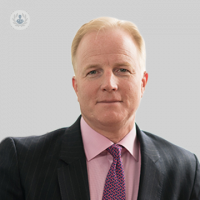Scoliosis surgery – what are the latest advances?
Written by:In broad terms, there are two types: paediatric scoliosis and adult scoliosis. It most commonly starts in patients aged between 11-18 years old and affects girls more than boys. It does not usually improve without treatment, however, it isn’t usually a sign of anything more serious. If you are concerned about scoliosis, book an appointment with a specialist.

What are the different types of scoliosis?
In the paediatric group, the most common patients seen are termed idiopathic which means the true cause of the scoliosis is unknown, but is probably a combination of genetic and environmental factors. Some of these curvatures will go on to need surgical intervention, while some will just be monitored. Some patients may be braced for a period of time until skeletal maturity.
In the adult population, two types are seen. The patients who were not treated as an adolescent, and the patients who have what is called De Novo degenerative scoliosis. This type of scoliosis is mainly due to wear and tear, but can also cause the same lateral curvature of the spine that happens in the paediatric population.
Scoliosis surgery: what are the new technologies?
The main aim of scoliosis surgery is to correct the curvature. In paediatric patients, the aim is to guide the growth of the spine, and reduce the chance of having to fuse the spine too early. Essentially, the option of surgery is used to try to guide the growth to make sure that the patient’s spine doesn’t have to be fused too early.
Magnetic technology: In the past, growth rods have been placed into the spine to try to lengthen the spine sequentially as the young child grows. This procedure can now be done remotely with magnetic technology.
Tethering: Another new technique that is starting to be adopted is called tethering, which is to stunt the growth by putting implants on the long side of a curvature to allow the shorter side of a curve to catch up and therefore to normalise the spine and potentially give a cure for the patients.
Computer-assisted surgery: In all types of surgery, both paediatric and adult, spinal navigation computer-assisted surgery has made surgery a lot safer. In time, robotic assisted surgery will be used in spinal surgery.
Navigation surgery has been used in brain surgery for a number of years and has now been adapted for use in spinal surgery. The spine can be very curved and the anatomy can be quite abnormal. Navigation surgery allows screws to be placed into the spine in a safe way avoiding the spinal cord.
In basic terms, a patient is scanned on the operative table. The scan then works as a template for the surgeons, and every instrument that is used has markers on them that can be seen by a camera. The computer can then help to guide the instruments so that the spinal cord can be avoided. This means that much safer surgery can be performed.
Scoliosis surgery: how is recovery time reduced?
An enhanced recovery programme aids the recovery of patients, one of the most important aspects of which is patient education. The patient will be informed what type of surgery they’re going to have, how it is going to feel, what is going to happen to them in the recovery period, and how they’re going to rehabilitate after that.
Other techniques can potentially lead to better outcomes, increased recovery and less chance of a need for revision surgery.


